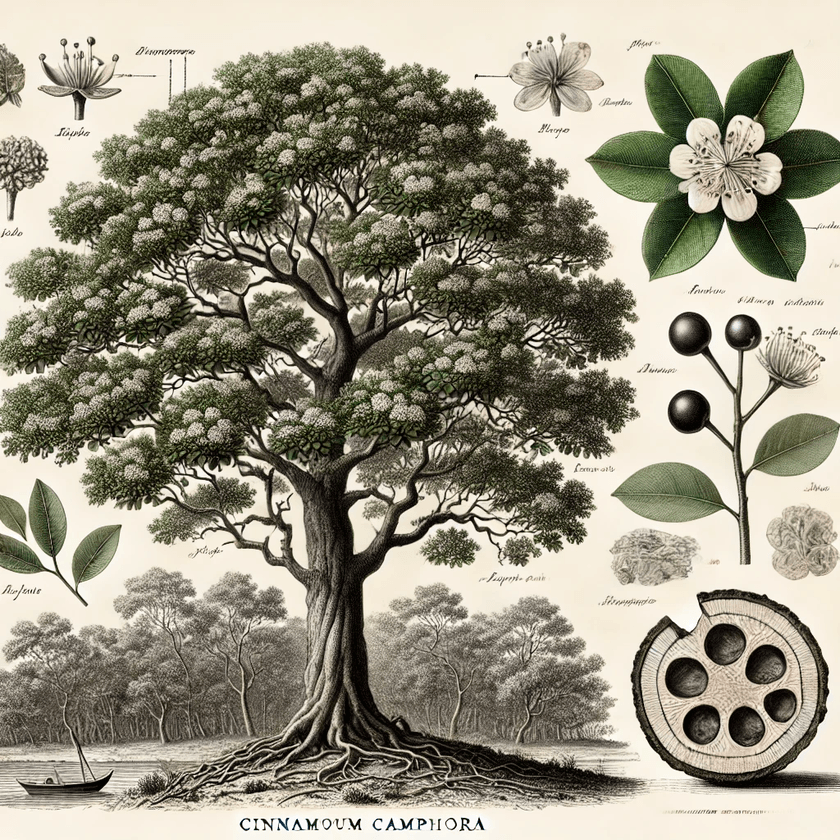An Extensive Botanical Exploration
Cinnamomum camphora, commonly known as the camphor tree, is an impressive tree renowned for its aromatic wood and the production of camphor. This tree has a rich history and is widespread in various parts of the world, primarily in Asia. In this comprehensive article, we will explore the origin, botanical characteristics, ecology, uses, cultural significance, and current status of Cinnamomum camphora.
Origin and Distribution
The camphor tree is native to East Asia, particularly China, Japan, and Taiwan. In these regions, the tree grows abundantly and plays a significant role in both the natural and cultural environment. The tree has also been introduced to other parts of the world, such as South Africa, Australia, and the United States, where it is cultivated as an ornamental plant and for commercial purposes.
Botanical Characteristics
Cinnamomum camphora is an evergreen tree that can reach heights of 20 to 30 meters. The tree has a broad, spreading crown and a sturdy trunk. Some notable botanical characteristics include:
- Leaves: The leaves of the camphor tree are glossy, dark green, and leathery, with a lanceolate to oval shape. They emit a distinctive aroma when crushed, due to the presence of essential oils.
- Flowers: The tree produces small, white flowers that grow in panicles. These flowers usually appear in spring and have a subtle, pleasant fragrance.
- Fruits: After flowering, the tree develops berry-like fruits that turn black when ripe. These fruits contain seeds that are dispersed by birds.
Ecology and Growing Conditions
The camphor tree thrives in tropical and subtropical climates. It prefers well-drained, fertile soil and can tolerate drought and various soil types. The tree grows best in full sun, though it can tolerate some shade. Due to its robustness, it is often planted as a windbreak or shade provider in parks and gardens.
Chemical Composition
The primary active components of Cinnamomum camphora are camphor, cineole, safrole, and linalool. Camphor is the most prominent compound and is extracted from the wood and leaves of the tree. These compounds have various applications in medicine, cosmetics, and industrial products.
Uses
Cinnamomum camphora has a wide range of uses, both traditional and modern:
- Medicinal: Camphor, the main product of the tree, has antiseptic, anti-inflammatory, and analgesic properties. It is used in creams, ointments, and inhalation products to treat muscle pain, congestion, and skin irritations.
- Aromatherapy: Camphor oil is widely used in aromatherapy for its refreshing and stimulating scent. It helps relieve stress, fatigue, and headaches.
- Woodworking: The wood of the camphor tree is durable and resistant to insects and rot, making it valuable for furniture making and wood carving.
- Insect Repellent: Camphor is traditionally used as an insect repellent in mothballs and sprays to protect clothing and textiles from moths and other insects.
Cultural Significance
In various Asian cultures, the camphor tree holds deep symbolic and practical significance. In China and Japan, the tree is often planted near temples and sacred sites due to its spiritual significance. It is seen as a symbol of strength and endurance. Camphor is also used in religious ceremonies and rituals, such as burning camphor to purify the surroundings and ward off negative energies.
Current Status and Conservation
Although the camphor tree is widespread and not considered endangered, there are challenges regarding the conservation of natural populations. Overexploitation for wood and camphor production has led to a decline in wild trees in some regions. Additionally, the introduction of the tree in non-native areas can lead to ecological disruptions, as it can become invasive and displace local flora.
Sustainable Use and Future Prospects
Sustainable management of Cinnamomum camphora is essential to preserve the benefits of this tree without harming natural populations and ecosystems. Initiatives such as controlled logging, planting trees in non-sensitive areas, and researching synthetic alternatives to camphor can contribute to a balanced approach.
Conclusion
Cinnamomum camphora, the camphor tree, is a remarkable tree with a rich history and a wide range of applications. From its medicinal and aromatherapeutic properties to its cultural and ecological significance, this tree remains a valuable resource in various parts of the world. Through sustainable use and conservation, we can ensure that future generations continue to benefit from the many advantages that the camphor tree offers.

Enjoy your exploration of the wonderful world of botany! 🏆🌳
Invest in your future
Take time to learn
Embark on your journey in affiliate marketing and website creation alongside an incredible community and myself. Invest in your future by dedicating time to learn and earn. Take all the time you need to master the basics before aiming higher. Give it a try and sign up for free. You won't regret it! Discover the possibilities for yourself...


